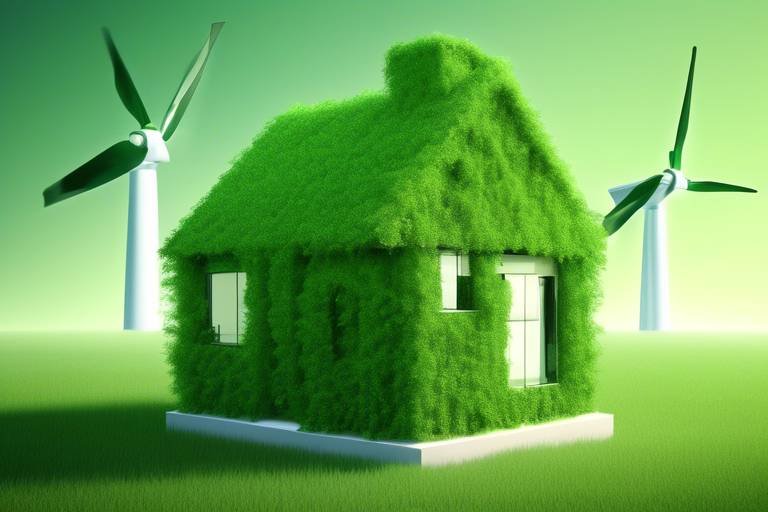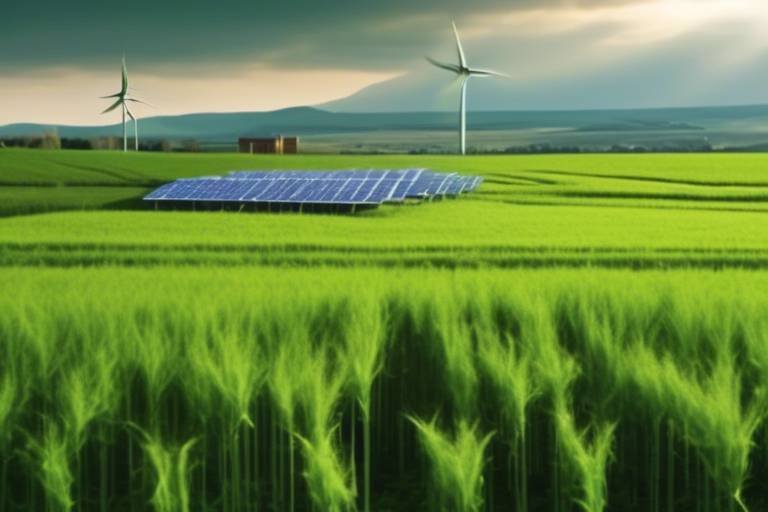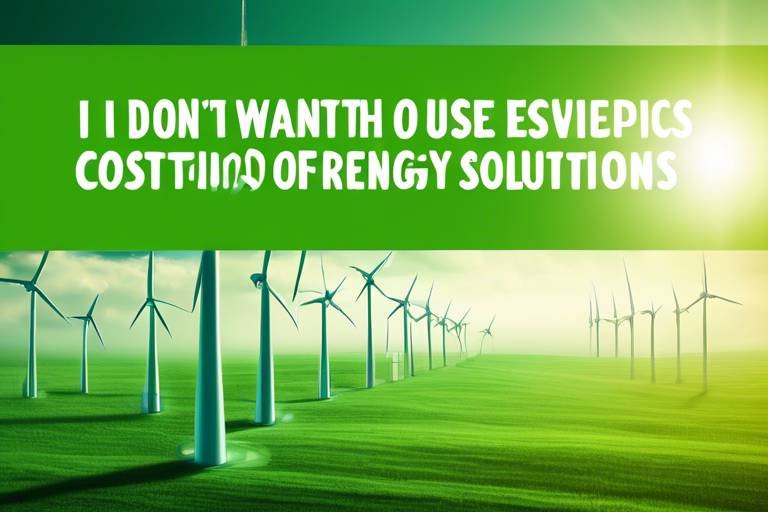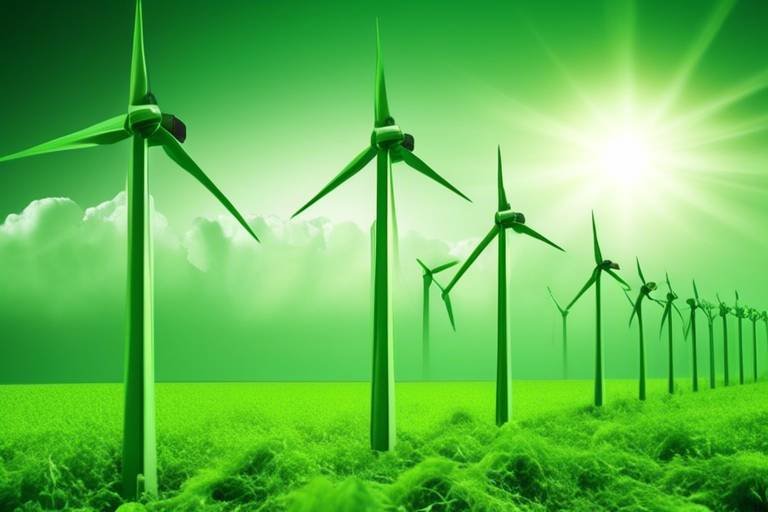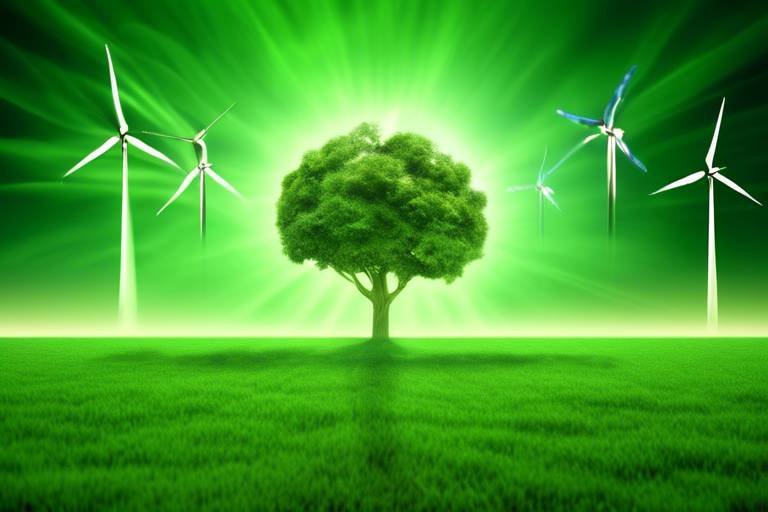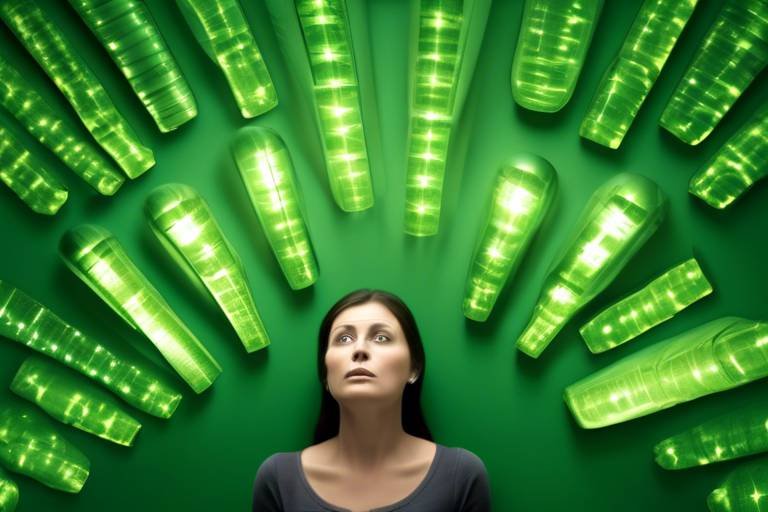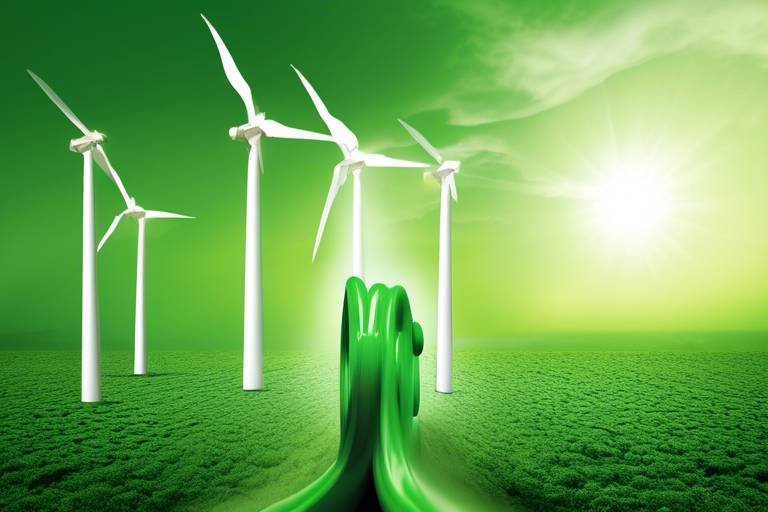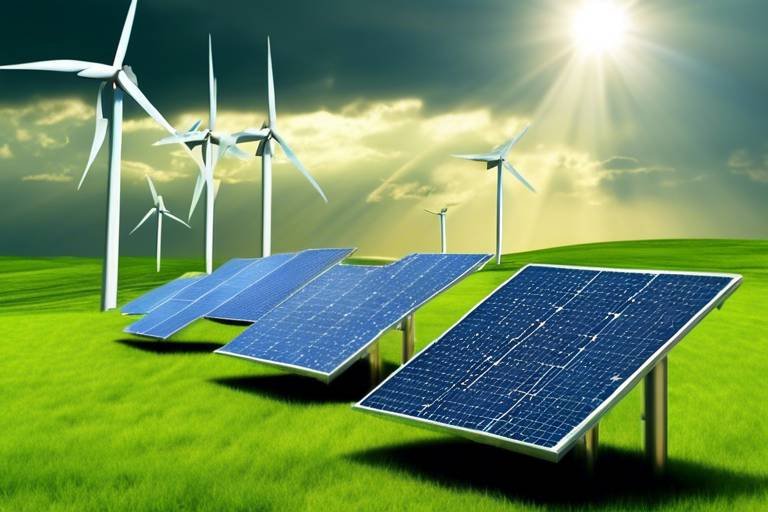Converting your Home into a Green Energy Power Plant
Have you ever dreamed of turning your home into a self-sustaining power plant? Well, it's not just a dream anymore! With the growing awareness of climate change and the need for sustainable living, many homeowners are now looking to convert their residences into green energy power plants. This transition not only helps reduce your carbon footprint but can also lead to significant savings on energy costs. Imagine a world where your home generates its own electricity, and you can enjoy the benefits of clean energy without the worry of rising utility bills. In this article, we'll explore how you can make this transition, the types of renewable energy available, and the financial incentives that can make it easier than ever.
So, what exactly is green energy? In simple terms, it refers to energy derived from renewable sources that are environmentally friendly. Unlike fossil fuels, which emit harmful pollutants and contribute to climate change, green energy sources help reduce greenhouse gas emissions. There are several types of green energy that homeowners can consider:
- Solar Energy: Harnessing the sun's power through solar panels to generate electricity.
- Wind Energy: Using wind turbines to convert wind power into electrical energy.
- Geothermal Energy: Utilizing heat from the earth's core for heating and electricity generation.
Each of these energy sources comes with its own set of benefits. For instance, solar energy is abundant and can be harnessed almost anywhere, while wind energy is particularly effective in open areas. By understanding these options, you can choose the best renewable energy system for your home.
Before diving into the world of green energy, it's crucial to understand your home's current energy consumption. This assessment will help you identify areas where you can improve efficiency and determine the best renewable energy systems to install. Start by examining your utility bills to get a sense of your energy usage patterns. Look for peak usage times and consider how different appliances contribute to your overall consumption.
An energy audit is a systematic approach to identifying inefficiencies in your home. You can perform a basic energy audit yourself by checking for drafts, inspecting insulation, and reviewing your appliances. Alternatively, hiring a professional can provide a more comprehensive analysis. A professional energy audit can uncover hidden issues and offer tailored solutions that can significantly improve your home's energy efficiency.
Understanding where energy loss occurs is crucial for maximizing your home's efficiency. Common areas where energy is wasted include:
- Drafty windows and doors
- Insufficient insulation in attics and walls
- Old, inefficient appliances
By addressing these issues, you can reduce your energy consumption and make your home more conducive to a green energy upgrade.
Estimating potential energy savings is vital for planning your green energy project. Consider the following methods to calculate savings:
- Compare your current energy bills to projected costs after implementing energy-efficient upgrades.
- Research the average energy production of the renewable systems you are considering.
By understanding your potential savings, you can make informed decisions about which energy-efficient upgrades to prioritize.
Now that you've assessed your home's energy needs, it's time to select the right renewable energy system. Each option has its pros and cons, so it's essential to consider factors such as your location, budget, and energy requirements. For instance, if you live in a sunny area, solar panels may be the best choice. On the other hand, if you have a lot of open space, wind turbines could be a viable option. Geothermal systems are excellent for those who want to tap into the earth's natural heat, but they may require more upfront investment.
Investing in green energy can be costly upfront, but there are numerous financing options available to help you make the transition. From loans to grants, these resources can ease the financial burden and make it easier to achieve your green energy goals.
Many governments offer incentives for homeowners who invest in green energy projects. These can include tax credits, rebates, and grants designed to offset the initial costs. Research the programs available in your area to take full advantage of these opportunities.
While initial costs can be high, the long-term savings from green energy can be significant. Not only will you save on energy bills, but your property's value may also increase as more buyers look for homes equipped with renewable energy systems. Over time, the investment in green energy can pay off, making it a financially sound choice.
Proper maintenance is essential for the longevity and efficiency of your green energy systems. Regular upkeep ensures that your solar panels, wind turbines, and other systems operate at peak efficiency, maximizing your energy savings.
Routine inspections are necessary to ensure optimal performance. Look out for signs of wear and tear, and don't hesitate to call professionals when needed. A little maintenance can go a long way in preserving your investment.
As technology evolves, upgrades may be necessary to maintain efficiency and performance. Keep an eye on advancements in renewable energy technology and be ready to adapt your systems as needed.
Converting your home into a green energy power plant not only benefits you but also has a positive impact on the community and the environment. By adopting renewable energy, you're contributing to a larger movement toward sustainability.
Your green energy efforts can inspire others. When neighbors see your commitment to sustainability, they may be motivated to explore similar options, creating a ripple effect that fosters a more sustainable community.
Transitioning to green energy significantly reduces your carbon footprint. Every small action contributes to combating climate change and promoting environmental health. By making conscious choices about your energy sources, you are playing a vital role in protecting our planet for future generations.
Q: How much can I save by switching to green energy?
A: Savings can vary based on your energy consumption and the systems you choose, but many homeowners see a significant reduction in their energy bills over time.
Q: Are there any government incentives for switching to renewable energy?
A: Yes, many governments offer tax credits, rebates, and grants for homeowners who invest in green energy systems.
Q: What type of renewable energy system is best for my home?
A: It depends on your location, energy needs, and budget. Solar panels are great for sunny areas, while wind turbines are effective in open spaces.
Q: Do I need a professional to conduct an energy audit?
A: While you can perform a basic audit yourself, hiring a professional can provide a more thorough assessment and tailored recommendations.

Understanding Green Energy
When we talk about green energy, we're diving into a world of renewable energy sources that are not only efficient but also kind to our planet. Imagine harnessing the power of the sun, the wind, or even the heat from the earth itself to fuel your home. Sounds like something out of a sci-fi movie, right? But this is the reality we can create today! Green energy encompasses a variety of sources, each with its unique benefits and potential for homeowners looking to make a positive impact.
Let’s break down some of the most popular types of green energy:
- Solar Energy: This is perhaps the most well-known form of green energy. By installing solar panels on your roof, you can convert sunlight into electricity, significantly reducing your reliance on fossil fuels.
- Wind Energy: If you live in an area with consistent winds, small wind turbines can be a fantastic way to generate your own electricity. They work by capturing wind energy and converting it into power.
- Geothermal Energy: This lesser-known source taps into the earth's internal heat. By installing geothermal heat pumps, you can efficiently heat and cool your home while drastically lowering your energy bills.
Now, you might be wondering, “What’s in it for me?” Well, aside from the obvious environmental benefits, transitioning to green energy can lead to substantial cost savings over time. By reducing your dependency on traditional energy sources, you can lower your monthly utility bills and even earn credits through net metering programs if you generate more energy than you consume.
Moreover, using renewable energy sources contributes to a healthier environment. It helps in reducing greenhouse gas emissions, which are a significant contributor to climate change. By making the switch, you’re not just investing in your home; you’re also playing a crucial role in the fight against global warming. It’s like planting a tree that will continue to grow and provide benefits for generations to come.
In addition to individual benefits, adopting green energy can lead to broader social impacts. Communities that embrace renewable energy often experience a boost in local economies through job creation in the green technology sector. This shift not only enhances energy independence but also fosters a sense of community pride as residents work together toward a sustainable future.
In summary, understanding green energy is about recognizing the potential it has to transform our homes, our finances, and our planet. As we explore further into the process of converting your home into a green energy power plant, keep in mind that every small step counts. Whether it's installing solar panels, harnessing wind energy, or utilizing geothermal systems, each choice you make contributes to a larger movement towards sustainability.

Assessing Your Home's Energy Needs
Before diving headfirst into the world of green energy, it’s crucial to take a step back and assess your home's energy consumption. Think of it like getting a health check-up before starting a new fitness regime; you want to know where you stand before making changes. Understanding your energy needs is the first step toward transforming your home into a self-sustaining power plant. So, how do you go about this? Let’s break it down!
Start by gathering your energy bills from the past year. This will give you a clear picture of your monthly energy consumption. You can calculate your average energy use by adding up your total consumption over the year and dividing it by 12. For example, if your total energy consumption for the year was 12,000 kWh, your average monthly use would be 1,000 kWh. This number is crucial as it helps you determine how much energy you need to generate with your renewable energy systems.
Next, consider the different aspects of your home that contribute to energy consumption. Here are a few key areas to evaluate:
- Heating and Cooling: HVAC systems can be significant energy hogs. Are you using an energy-efficient system? Are there drafts in your home?
- Appliances: Older appliances tend to consume more energy. Check the energy ratings of your major appliances and consider upgrading to energy-efficient models.
- Lighting: Switching to LED lighting can drastically reduce your energy consumption. Are you still using incandescent bulbs?
Once you have a good grasp of your current energy use, it’s time to conduct an energy audit. This process involves evaluating your home’s energy efficiency and identifying areas where you can improve. You can perform a basic energy audit yourself or hire a professional for a more comprehensive assessment. A professional audit typically includes a blower door test, infrared camera inspection, and a detailed report on energy loss areas.
To perform a basic energy audit on your own, follow these steps:
- Inspect Your Home: Walk through your home and look for drafts, insulation problems, and outdated appliances.
- Check Your Energy Bills: Review your energy bills for any spikes in usage and identify when they occur.
- Use Energy Audit Tools: Consider using tools like watt meters to measure the energy consumption of individual appliances.
After conducting your audit, you’ll have a clearer idea of where your home stands in terms of energy efficiency. You might discover that your home is losing energy through poorly insulated windows or that your heating system is outdated. Addressing these issues not only helps in reducing your energy needs but also prepares your home for the integration of renewable energy systems.
Understanding where energy loss occurs is crucial for effective energy management. Common areas of energy loss include:
- Windows and Doors: Poorly sealed windows and doors can lead to significant heat loss.
- Attics and Basements: Insufficient insulation in these areas can cause temperature fluctuations, leading to higher energy use.
- HVAC Ducts: Leaky ducts can waste a lot of energy, especially in homes with central heating and cooling systems.
By identifying these energy loss areas, you can take targeted actions to improve your home's efficiency. Simple fixes like weather stripping around doors and windows or adding insulation to your attic can make a world of difference.
After you’ve made improvements, it’s important to estimate the potential energy savings you can achieve. You can use online calculators or consult with energy professionals to help you gauge the impact of your upgrades. Typically, energy-efficient upgrades can lead to savings of 10% to 30% on your energy bills. This is not just a win for your wallet; it’s also a step toward a greener home!
In conclusion, assessing your home’s energy needs is not just about crunching numbers; it’s about understanding your lifestyle and how you can align it with sustainable practices. By taking the time to evaluate your current consumption, conducting an energy audit, and identifying areas for improvement, you’ll be well on your way to converting your home into a green energy power plant.
Q: How often should I conduct an energy audit?
A: It's advisable to conduct an energy audit at least once a year, especially before making significant upgrades or changes to your home.
Q: Can I perform an energy audit myself?
A: Yes, you can perform a basic energy audit yourself, but for a thorough assessment, hiring a professional is recommended.
Q: What are some quick fixes to reduce energy loss?
A: Simple fixes include sealing drafts, insulating your attic, and upgrading to energy-efficient appliances.

Conducting an Energy Audit
Conducting an energy audit is a crucial step in your journey toward transforming your home into a green energy power plant. Think of it as a health check-up for your home’s energy efficiency. Just like you would want to know how your body is functioning, understanding your home’s energy consumption can reveal inefficiencies that are draining your resources and increasing your carbon footprint. An energy audit helps you identify where energy is being wasted, allowing you to make informed decisions about upgrades and improvements.
So, how do you go about conducting an energy audit? You can either take the DIY route or hire a professional. If you choose to do it yourself, you’ll want to start by gathering some essential tools: a notepad, a flashlight, and possibly a thermal imaging camera if you have access to one. Begin your audit by walking through your home and observing areas where energy may be leaking. This includes checking windows and doors for drafts, inspecting insulation levels, and assessing your heating and cooling systems. You might be surprised at how many small changes can lead to significant energy savings!
Here’s a quick checklist of areas to focus on during your audit:
- Insulation: Check the attic, walls, and floors for adequate insulation.
- Windows and Doors: Look for gaps and ensure they are properly sealed.
- Heating and Cooling Systems: Inspect for efficiency and maintenance needs.
- Appliances: Evaluate the energy ratings of your appliances and consider energy-efficient upgrades.
For those who prefer a more thorough assessment, hiring a professional energy auditor can provide you with a detailed report and recommendations tailored to your home. Professionals often use advanced tools, such as blower door tests and infrared cameras, to identify issues that might not be visible to the naked eye. They will analyze your energy consumption patterns and suggest effective strategies to reduce waste.
After completing your audit, it’s essential to analyze the findings. Consider creating a table to track your energy usage before and after implementing changes. This will help you visualize your progress and understand the impact of your efforts.
| Energy Source | Before Audit (kWh/month) | After Audit (kWh/month) | Potential Savings (kWh/month) |
|---|---|---|---|
| Heating | 500 | 350 | 150 |
| Cooling | 300 | 200 | 100 |
| Lighting | 150 | 100 | 50 |
| Appliances | 400 | 300 | 100 |
In conclusion, conducting an energy audit is not just about finding faults; it’s about discovering opportunities. By understanding your home's energy needs and taking proactive steps to address inefficiencies, you can significantly reduce your energy consumption, lower your bills, and contribute to a healthier planet. Remember, every little bit counts, and your efforts can inspire others to follow suit!
Q: What is an energy audit?
A: An energy audit is an assessment of your home’s energy use to identify areas where you can improve efficiency and reduce waste.
Q: Can I conduct an energy audit myself?
A: Yes, you can perform a basic energy audit yourself using simple tools and a checklist, but hiring a professional can provide more in-depth insights.
Q: How often should I conduct an energy audit?
A: It’s a good idea to conduct an energy audit every few years or whenever you make significant changes to your home, such as renovations or new appliances.

Identifying Energy Loss Areas
When it comes to converting your home into a green energy power plant, one of the most crucial steps is identifying where energy loss occurs. Think of your home as a ship; if there are leaks, no matter how much fuel you have, it won't get you very far. Energy loss can happen in various areas, and being aware of these spots can help you take corrective action and maximize your energy efficiency.
Typically, energy loss in homes can be attributed to several common culprits. The most significant areas include:
- Windows and Doors: Poorly sealed windows and doors can be major energy offenders. If you can feel drafts or see light around the edges, it’s time to consider weather stripping or caulking.
- Insulation: Insufficient insulation in attics, walls, and floors can lead to significant heat loss in winter and heat gain in summer. This is like having a blanket that’s too thin for the cold nights!
- HVAC Systems: An inefficient heating, ventilation, and air conditioning system can consume more energy than necessary. Regular maintenance and upgrades can help keep these systems running smoothly.
- Appliances: Older appliances often use more energy than their modern counterparts. Consider replacing them with energy-efficient models to save both energy and money.
To effectively identify these energy loss areas, you might want to conduct a simple energy audit. This can involve checking for drafts around windows and doors, inspecting insulation levels, and evaluating the efficiency of your HVAC system. If you're not comfortable doing this yourself, hiring a professional energy auditor can provide a detailed analysis and recommendations for improvement.
In addition to these physical inspections, it’s also wise to monitor your energy bills. A sudden spike in usage can indicate a problem in one of these areas. Keeping an eye on your consumption patterns can help you pinpoint when and where energy loss is occurring.
By addressing these energy loss areas, not only will you enhance the efficiency of your home, but you'll also be taking significant steps towards reducing your carbon footprint. Every little bit counts, and by making these changes, you’re not just saving money; you’re also contributing to a healthier planet.
- What are the most common areas for energy loss in homes? Typically, windows and doors, insulation, HVAC systems, and older appliances are where most energy loss occurs.
- How can I check for drafts in my home? A simple way to check for drafts is to light an incense stick and move it around windows and doors. If the smoke wavers, you likely have a draft.
- Is it worth hiring a professional for an energy audit? Yes! A professional energy audit can provide a comprehensive understanding of your home’s energy efficiency and offer tailored solutions.

Calculating Energy Savings
When it comes to transitioning your home into a green energy power plant, understanding how to calculate your energy savings is crucial. This process not only helps you gauge the financial viability of your investments but also gives you a clearer picture of how much you can save over time. Imagine knowing exactly how much your renewable energy systems can cut down your electricity bills—it’s like having a financial crystal ball!
To start with, you need to look at your current energy consumption. This means gathering your utility bills from the past year to find out how much energy you’ve been using. Once you have that information, you can begin to estimate your potential savings by implementing energy-efficient upgrades and renewable energy systems. For instance, if your average monthly electricity bill is $150, that translates to $1,800 a year. Now, consider a solar panel system that could potentially reduce your bill by 50%. That’s a whopping $900 saved annually!
Next, let’s break down how to calculate the savings from specific upgrades. You can use the following formula:
| Upgrade Type | Initial Cost | Annual Savings | Payback Period (Years) |
|---|---|---|---|
| Solar Panels | $15,000 | $900 | 16.67 |
| Energy-Efficient Windows | $10,000 | $400 | 25 |
| Insulation Upgrade | $5,000 | $300 | 16.67 |
This table illustrates how different upgrades can impact your finances. The payback period is calculated by dividing the initial cost by the annual savings. The shorter the payback period, the quicker you’ll see a return on your investment. For solar panels, while the initial cost is higher, the savings can accumulate over time, making it a worthwhile investment.
Additionally, consider the long-term benefits of energy-efficient upgrades. Not only do they reduce your bills, but they also increase your home’s value, making it a win-win situation. When potential buyers see that your home is equipped with renewable energy systems, they often perceive it as a more attractive option, which can lead to a higher sale price.
Another important factor to consider is the impact of government incentives. Many regions offer tax credits and rebates for homeowners who invest in green energy. This can significantly lower the upfront costs and improve your overall savings. For example, if you qualify for a 30% federal tax credit on a $15,000 solar panel installation, you’ll save an additional $4,500 right off the bat!
In summary, calculating your energy savings involves analyzing your current energy use, estimating potential savings from upgrades, and factoring in government incentives. By taking these steps, you’ll not only be able to make informed decisions about your investments but also enjoy the peace of mind that comes from knowing you’re contributing to a greener planet while saving money in the process.
- What is the average payback period for solar panels? The average payback period for solar panels typically ranges from 5 to 15 years, depending on various factors including location, energy consumption, and available incentives.
- Can I combine different renewable energy systems? Absolutely! Many homeowners combine solar panels with wind turbines or geothermal systems to maximize their energy savings and efficiency.
- How can I find out about local incentives for green energy? You can check with your local government or utility provider for available incentives. Websites like the Database of State Incentives for Renewables & Efficiency (DSIRE) can also provide valuable information.

Choosing Renewable Energy Systems
When it comes to transforming your home into a green energy power plant, one of the most critical steps is choosing the right renewable energy system. With various options available, it can feel overwhelming to determine which is best suited for your specific needs. So, how do you navigate this maze of possibilities? Let's break it down.
First off, it's essential to consider the energy resources available in your area. Do you live in a sunny region? Solar panels might be your best bet. If you’re in a windy area, perhaps a wind turbine could be the answer. Geothermal systems are excellent for those with access to suitable underground heat sources. Each system has its unique benefits and drawbacks, and understanding these can help you make an informed decision.
Here’s a quick overview of the three most popular renewable energy systems:
| Energy System | Best For | Pros | Cons |
|---|---|---|---|
| Solar Panels | Sunny Locations | Low maintenance, reduces electricity bills | High initial cost, dependent on sunlight |
| Wind Turbines | Windy Areas | Generates energy day and night, low operational costs | Requires space, noise concerns |
| Geothermal Systems | Areas with geothermal activity | Stable energy source, low emissions | High installation costs, site-specific |
Once you've identified the systems that align with your location, it’s time to consider your energy needs. How much energy do you consume on a daily basis? What appliances do you use? Understanding your energy consumption will help you determine the size and capacity of the system you need. For instance, a family that uses a lot of electricity for heating and cooling might require a more robust system than a household that primarily uses energy for lighting and small appliances.
Another factor to consider is the initial investment versus long-term savings. While some systems may have a higher upfront cost, they often lead to significant savings on energy bills over time. For example, solar panels might seem pricey at first, but with various government incentives and rebates, the return on investment can be quite favorable. Plus, as energy prices continue to rise, having your own energy source can provide financial security.
Finally, don’t forget about local regulations and incentives. Some areas offer tax credits, rebates, or even grants to homeowners who invest in renewable energy systems. Researching these opportunities can significantly lower your overall costs and make the transition to green energy even more appealing.
In conclusion, choosing the right renewable energy system is a multifaceted decision that involves assessing your location, energy needs, financial considerations, and local incentives. By taking the time to evaluate these factors, you can make a choice that not only benefits your household but also contributes to a more sustainable future.
- What is the most cost-effective renewable energy system? The answer depends on your location and energy needs, but solar panels are often considered a wise investment due to their decreasing costs and available incentives.
- How do I know if my home is suitable for solar panels? A professional assessment can determine if your roof has adequate sunlight exposure and structural integrity for solar installation.
- Are renewable energy systems reliable? Yes, most renewable energy systems are designed to be reliable and efficient, especially when properly maintained.

Financing Your Green Energy Project
Investing in a green energy project can feel like a daunting task, especially when you consider the upfront costs involved. However, the transition to renewable energy sources is not only an environmentally responsible choice but also a financially savvy one in the long run. As you embark on this journey, it's crucial to explore various financing options that can help you manage the initial expenses. From loans to grants, there are numerous avenues available to homeowners looking to convert their homes into self-sustaining power plants.
One of the most common financing methods is to take out a green loan. These loans are specifically designed for energy-efficient home improvements and renewable energy installations. They often come with lower interest rates and favorable repayment terms, making them an attractive option for homeowners. Additionally, many financial institutions now offer home equity loans or lines of credit, allowing you to tap into the equity you've built in your home to fund your green energy project.
Another avenue worth exploring is government grants and incentives. Many local, state, and federal programs exist to encourage homeowners to adopt renewable energy solutions. These incentives can significantly offset the costs associated with purchasing and installing solar panels, wind turbines, or geothermal systems. For instance, the Federal Investment Tax Credit (ITC) allows homeowners to deduct a percentage of the cost of installing a solar energy system from their federal taxes. It’s essential to research the specific programs available in your area, as they can vary widely.
In addition to grants, some utility companies offer rebate programs for homeowners who invest in renewable energy systems. These rebates can provide a substantial return on your investment, making the switch to green energy even more appealing. To maximize your savings, consider reaching out to your utility provider to inquire about available programs.
| Financing Option | Description | Potential Benefits |
|---|---|---|
| Green Loans | Loans specifically for energy-efficient upgrades. | Lower interest rates and favorable terms. |
| Government Grants | Financial aid from government programs. | Significantly reduce installation costs. |
| Utility Rebates | Rebates offered by utility companies for renewable energy systems. | Direct savings on system costs. |
While these financing options can help alleviate the burden of upfront costs, it's also important to consider the long-term financial benefits of investing in green energy. Although the initial investment may seem high, the savings on your utility bills can quickly add up. Additionally, homes equipped with renewable energy systems often see an increase in property value. Prospective buyers are increasingly looking for energy-efficient homes, and having a green energy system can set your property apart in the real estate market.
In conclusion, financing your green energy project is not just about finding the right loan or grant; it's about understanding the full scope of benefits that come with making your home more energy-efficient. By exploring all available options and considering the long-term advantages, you can make a well-informed decision that benefits both your wallet and the planet.
- What are the best financing options for green energy projects? Green loans, government grants, and utility rebates are some of the best options available.
- How can I find out about local incentives? Check with your local government or utility company for information on available programs.
- Are there any tax benefits to installing renewable energy systems? Yes, many homeowners can benefit from tax credits and deductions, such as the Federal Investment Tax Credit for solar installations.

Government Incentives and Rebates
When it comes to converting your home into a green energy power plant, one of the most attractive aspects is the array of available to homeowners. These financial aids can significantly reduce the initial costs associated with installing renewable energy systems, making the transition not only environmentally friendly but also economically feasible. But what exactly are these incentives, and how can you take advantage of them?
First off, many governments offer tax credits for homeowners who invest in renewable energy technologies. For example, in the United States, the federal government has provided a tax credit for solar energy systems that allows homeowners to deduct a percentage of the installation costs from their federal taxes. This can lead to substantial savings. Additionally, some states and local governments offer their own tax incentives, which can further enhance your savings.
In addition to tax credits, there are often rebate programs that provide direct cash back for the installation of green energy systems. These programs vary widely by location and can cover various technologies, including solar panels, wind turbines, and energy-efficient appliances. To find out what’s available in your area, you can check with your local energy provider or state energy office, as they typically have updated information on available programs.
Another option to consider is low-interest loans specifically designed for renewable energy projects. These loans can help you finance the upfront costs while paying them back over time, often at a lower interest rate than traditional loans. Some programs even offer on-bill financing, where the loan repayment is included in your monthly utility bill, making it easier to manage your budget.
It's also worth noting that some utility companies have incentive programs that reward homeowners for generating their own energy. For instance, net metering allows you to sell excess energy back to the grid, which can significantly offset your energy costs. This not only benefits your wallet but also contributes to a more sustainable energy system overall.
To maximize your benefits, it's crucial to stay informed about the various incentives available. Many programs have specific eligibility requirements and deadlines, so doing your homework can pay off. Websites like the Database of State Incentives for Renewables & Efficiency (DSIRE) are excellent resources for finding detailed information about incentives in your state.
In conclusion, government incentives and rebates play a vital role in making renewable energy accessible to homeowners. By taking advantage of these financial aids, you can reduce your initial investment and accelerate your journey towards a sustainable and self-sufficient energy future.
- What types of incentives are available for green energy projects? Incentives can include tax credits, rebates, low-interest loans, and net metering programs, which vary by location.
- How can I find out about local incentives? Check with your local energy provider or visit websites like the Database of State Incentives for Renewables & Efficiency (DSIRE).
- Are there any eligibility requirements for these incentives? Yes, many programs have specific eligibility criteria, so it's important to review these before applying.
- Can I combine multiple incentives? In many cases, homeowners can stack different incentives to maximize their savings, but it's essential to check the rules for each program.

Long-term Financial Benefits
When considering a switch to green energy, many homeowners might initially feel daunted by the upfront costs associated with solar panels, wind turbines, or geothermal systems. However, it’s crucial to look beyond those initial investments and focus on the that can significantly outweigh the costs. Imagine trading in your monthly energy bills for a steady stream of savings—sounds appealing, right?
One of the most compelling reasons to adopt renewable energy is the potential for substantial savings on your energy bills. Once your green energy system is installed, the sun or wind does the heavy lifting, allowing you to generate your own electricity. This could lead to a dramatic reduction in your utility bills, and depending on your location and energy consumption, it might even eliminate them altogether. For instance, homeowners who install solar panels can save anywhere from 20% to 50% on their monthly electricity costs.
In addition to lower energy bills, consider the increased property value that comes with a green energy upgrade. Homes equipped with renewable energy systems are often seen as more desirable in the real estate market. A study by the National Renewable Energy Laboratory (NREL) found that homes with solar panels sold for an average of 4.1% more than comparable homes without them. This means that not only do you save money while living in your home, but you also stand to profit when it’s time to sell.
Another financial benefit to keep in mind is the availability of government incentives and tax credits. Many states and federal programs offer significant rebates and tax deductions for homeowners who invest in renewable energy. For example, the Federal Investment Tax Credit (ITC) allows homeowners to deduct a percentage of their solar system's cost from their federal taxes. This can lead to savings of thousands of dollars, making the initial investment much more manageable.
To further illustrate the financial impact, let’s take a look at a simple comparison between traditional energy costs and green energy savings over a 20-year period:
| Energy Source | Average Monthly Cost | Total Cost Over 20 Years |
|---|---|---|
| Traditional Energy | $150 | $36,000 |
| Solar Energy | $50 (after savings) | $12,000 |
As shown in the table, switching to solar energy can lead to a staggering difference in total costs over two decades. The savings of $24,000 is not just a number; it represents financial freedom and the opportunity to invest that money elsewhere—perhaps into your children’s education, a vacation, or retirement savings.
In conclusion, while the initial investment in green energy might seem high, the long-term financial benefits are undeniable. From reduced energy bills and increased property value to government incentives, the advantages are numerous. So, if you’re still on the fence about making the switch, just think about all the ways you could save and invest your hard-earned money in the future.
- What are the main financial benefits of switching to green energy?
Switching to green energy can lead to lower utility bills, increased property value, and access to government incentives and tax credits. - How much can I save on my energy bills with renewable energy?
Many homeowners report savings of 20% to 50% on their energy bills after installing renewable energy systems. - Are there any financial incentives for installing solar panels?
Yes, many states and the federal government offer rebates and tax credits that can significantly reduce the initial costs of solar panel installation.

Maintaining Your Green Energy Systems
Maintaining your green energy systems is not just a chore; it's a crucial aspect of ensuring that your investment continues to pay off over time. Think of it like taking care of a garden. If you don't water it, prune it, and protect it from pests, it won't flourish. Similarly, your renewable energy systems—be it solar panels, wind turbines, or geothermal systems—require regular attention to function at their best. In this section, we’ll explore some essential maintenance practices that will help extend the lifespan and efficiency of your green energy solutions.
First and foremost, regular inspections are vital. Just as you would check your car for any unusual sounds or performance issues, you should routinely inspect your energy systems. For solar panels, this includes checking for dirt, debris, or any shading from nearby trees that could reduce efficiency. For wind turbines, ensure that the blades are free from obstructions and that there are no signs of wear and tear. If you’re not comfortable doing these inspections yourself, don’t hesitate to call in a professional who specializes in renewable energy systems.
Next, let’s talk about upkeep. Keeping your systems clean is essential. For solar panels, a simple wash with water can remove dirt and grime that accumulates over time. This is particularly important if you live in a dusty area or near the ocean, where salt can cling to surfaces. Wind turbines may also require occasional cleaning, especially if they are located in areas with high bird activity. Regular maintenance not only improves efficiency but can also prevent costly repairs down the line.
As technology continues to evolve, you may find that upgrading your systems becomes necessary. Just like upgrading your smartphone for better performance, your renewable energy systems may need enhancements to keep up with advances in technology. Signs that it might be time for an upgrade include decreased energy output or increased maintenance costs. Newer models can offer better efficiency and longer lifespans, making them worth the investment.
To summarize, here are some key points to remember about maintaining your green energy systems:
- Conduct regular inspections to identify any issues early.
- Keep your systems clean to maximize efficiency.
- Consider upgrades when performance declines or technology improves.
By taking these steps, you ensure that your green energy systems not only function optimally but also contribute to your home's sustainability for years to come. Remember, a little proactive maintenance can go a long way in protecting your investment and promoting a greener future.
1. How often should I inspect my solar panels?
It's recommended to inspect your solar panels at least twice a year, but more frequent checks after severe weather events are advisable.
2. Can I clean my solar panels myself?
Yes, you can clean your solar panels yourself using water and a soft brush, but ensure safety first. If you're unsure, hiring a professional is a good option.
3. What are the signs that my wind turbine needs maintenance?
Look for unusual noises, decreased energy output, or visible wear on the blades. If you notice any of these signs, it's time to schedule an inspection.
4. How do I know when to upgrade my energy systems?
If you're experiencing frequent maintenance issues or if newer models offer significantly better efficiency, consider upgrading your systems.

Regular Inspections and Upkeep
When it comes to maintaining your green energy systems, regular inspections and upkeep are crucial for ensuring they operate efficiently and effectively. Think of your renewable energy systems as a garden; if you don't tend to it, weeds will grow, and the plants won't thrive. Just like a garden needs regular watering and weeding, your solar panels, wind turbines, and geothermal systems require consistent attention to maximize their performance.
During inspections, you should look for several key indicators that can affect the efficiency of your systems. For solar panels, check for dirt, debris, or shading from nearby trees that could block sunlight. Wind turbines should be inspected for any signs of wear and tear, including blade damage or unusual noises that might indicate mechanical issues. Geothermal systems need periodic checks to ensure that the heat exchange fluids are functioning correctly and that the system is operating at optimal levels.
Here are some essential maintenance tips to consider:
- Solar Panels: Clean them at least twice a year, or more frequently if you live in a dusty area. Ensure there are no obstructions that could block sunlight.
- Wind Turbines: Inspect the blades for any damage, and check the mechanical components for wear. Lubricate moving parts as needed.
- Geothermal Systems: Schedule regular professional maintenance to check the heat pump and ensure that the system is operating efficiently.
It's also wise to keep a maintenance log. Documenting your inspections and any maintenance performed can help you track the performance of your systems over time and identify any recurring issues. If you're not comfortable performing these inspections yourself, consider hiring a professional. They can provide a thorough assessment and address any problems you might miss.
In summary, just as you wouldn't ignore your car's maintenance schedule, your green energy systems require regular attention to ensure they continue to deliver the benefits you've invested in. By staying proactive and conducting routine inspections, you'll not only enhance the longevity of your systems but also maximize your energy savings and reduce your environmental impact.
Q: How often should I inspect my solar panels?
A: It's recommended to inspect your solar panels at least twice a year, but you should check them more frequently if you live in a dusty area or near trees that may cast shadows.
Q: Can I perform maintenance on my wind turbine myself?
A: While some basic maintenance tasks can be done by homeowners, it's advisable to consult with professionals for thorough inspections and repairs.
Q: What signs indicate that my geothermal system needs maintenance?
A: If you notice a decrease in heating or cooling efficiency, unusual noises, or higher energy bills, it may be time to have your geothermal system inspected by a professional.

Upgrading Technology
As technology continues to evolve at a breakneck pace, it's crucial for homeowners to stay informed about the latest advancements in renewable energy systems. Upgrading your green energy technology can significantly enhance efficiency and performance, ensuring that your home remains a powerhouse of sustainable energy. But how do you know when it's time to make that leap? Well, there are several signs to look out for that can indicate your current systems may need an upgrade.
First and foremost, if your energy bills are creeping up despite your efforts to conserve energy, it might be time to assess your systems. Older solar panels, for instance, may not be capturing sunlight as efficiently as newer models. On average, solar technology improves by about 0.5% to 1% each year, meaning that a system that’s just a few years old could be significantly outperformed by the latest technology. If you notice a decrease in energy production or efficiency, it’s a clear signal that an upgrade could pay off.
Moreover, if your renewable energy systems require frequent repairs, it's a telltale sign that they might be nearing the end of their lifespan. Just like a car that’s constantly in the shop, older systems can become a financial burden rather than a source of savings. For example, if you find yourself repairing your wind turbine or solar panels multiple times a year, consider the cost of those repairs versus the cost of installing a new, more efficient system.
Another important factor to consider is the technological advancements in energy storage. If you currently rely on traditional batteries for energy storage, you might be missing out on newer, more efficient options like lithium-ion batteries that offer longer life cycles and better performance. Upgrading your storage system can enhance your energy independence, allowing you to store excess energy generated during sunny or windy days for use during peak demand times.
Lastly, don’t overlook the importance of compatibility. As you upgrade one component of your renewable energy system, ensure that it works seamlessly with the other parts. For instance, if you install new solar panels, make sure your inverter can handle the increased output. This holistic approach ensures that every element of your system works in harmony, maximizing your energy production and savings.
In summary, upgrading your green energy technology is not just about keeping up with trends; it's about maximizing the efficiency and sustainability of your home. By paying attention to signs like rising energy costs, frequent repairs, outdated storage solutions, and compatibility issues, you can make informed decisions that will benefit both your wallet and the environment.
- How often should I consider upgrading my renewable energy systems? It's recommended to evaluate your systems every 5 to 10 years, depending on their performance and technological advancements.
- What are the benefits of upgrading to newer technology? Upgrading can lead to increased efficiency, lower energy bills, and improved energy independence.
- Are there any financial incentives for upgrading my systems? Yes, many governments offer rebates and incentives for homeowners who invest in newer, more efficient renewable energy technologies.

Community and Environmental Impact
Converting your home into a green energy power plant is not just a personal victory; it’s a **triumph for the community and the environment** as well. Imagine a neighborhood where every house contributes to a cleaner, more sustainable future. When you harness renewable energy, like solar or wind power, you're not only reducing your reliance on fossil fuels but also setting an example for your neighbors. This shift can create a **ripple effect**, inspiring others to take similar steps toward sustainability.
One of the most significant impacts of adopting green energy is the reduction of our **carbon footprint**. By transitioning to renewable sources, you’re actively participating in the fight against climate change. Each kilowatt-hour of clean energy produced means one less kilowatt-hour generated from polluting sources. As individuals make these changes, the cumulative effect can lead to substantial decreases in greenhouse gas emissions. For instance, according to the Environmental Protection Agency (EPA), renewable energy sources could reduce carbon emissions by over **80%** by 2050 if widely adopted.
Moreover, your commitment to green energy can help build a more sustainable community. When homeowners invest in renewable energy, they often advocate for local policies that support clean energy initiatives. This can lead to the development of community solar projects, where multiple households share the benefits of solar power, or wind farms that provide energy to the entire region. Such projects not only lower energy costs but also foster a sense of **community spirit** and collaboration.
Additionally, the environmental benefits extend beyond just reducing carbon emissions. By opting for renewable energy, you’re also contributing to the preservation of natural resources. For example, solar energy harnesses the sun’s power, which is abundant and inexhaustible, while wind energy utilizes the natural movement of air. Both methods help decrease the demand for **non-renewable resources**, such as coal and natural gas, which are finite and harmful to the environment.
To further illustrate the impact of renewable energy on the community and environment, consider the following table:
| Impact Area | Benefits |
|---|---|
| Carbon Emissions | Significantly reduced, contributing to climate change mitigation |
| Local Economy | Stimulates job creation in green technology and installation sectors |
| Resource Preservation | Reduces dependence on finite fossil fuels, promoting sustainability |
| Community Engagement | Encourages collaboration and shared initiatives among neighbors |
By embracing renewable energy, you’re not just investing in your home; you’re investing in the **future of your community and the planet**. Your actions can inspire others to consider their energy choices, leading to a collective effort that can reshape our world for the better. So, as you embark on this journey to a greener lifestyle, remember that you’re part of a larger movement—a movement that is transforming communities and preserving our planet for generations to come.
- What are the main types of renewable energy? The most common types include solar, wind, hydroelectric, and geothermal energy.
- How can I assess my home's energy needs? Conducting an energy audit is a great start. You can either do it yourself or hire a professional.
- Are there financial incentives for switching to renewable energy? Yes, many governments offer loans, grants, and tax credits for homeowners who invest in green energy systems.
- How do I maintain my renewable energy systems? Regular inspections and upkeep are essential. Follow manufacturer guidelines and consider professional services when necessary.

Building a Sustainable Community
Transforming your home into a green energy power plant isn't just a personal victory; it can also be the spark that ignites a wave of change in your community. Imagine living in a neighborhood where every home is equipped with solar panels, wind turbines, or even geothermal systems. This vision is not just a dream; it's entirely possible when individuals take the initiative to adopt renewable energy solutions. By making your home more sustainable, you send a powerful message to your neighbors and inspire them to consider similar changes.
When you invest in green energy, you contribute to a collective effort that goes beyond just reducing your energy bills. You're also playing a crucial role in promoting environmental awareness and sustainability. Here are a few ways your actions can ripple through your community:
- Inspiring Others: Your commitment to renewable energy can motivate others to follow suit. When neighbors see your solar panels or wind turbine, they may become curious and start exploring their own options.
- Creating a Network: As more homeowners adopt green technologies, a network of like-minded individuals can form. This community can share resources, knowledge, and even group purchasing options for renewable energy systems.
- Advocating for Local Initiatives: A community that embraces sustainability can push for local policies that support renewable energy projects, such as tax incentives or community solar programs.
Moreover, the benefits extend beyond individual households. A community that prioritizes sustainability can experience enhanced property values, reduced energy costs, and improved air quality. These advantages create a healthier living environment for everyone. Think of it like planting a tree; one tree provides shade and beauty, but a grove of trees can transform an entire landscape.
Additionally, becoming a part of a sustainable community fosters a sense of belonging and shared purpose. You and your neighbors can collaborate on projects like community gardens, energy co-ops, or local clean-up days. These initiatives not only enhance your surroundings but also strengthen social ties and create a supportive network. When individuals band together for a common cause, the impact can be profound and far-reaching.
In conclusion, by converting your home into a green energy power plant, you are not just making an investment in your future; you are also paving the way for a more sustainable community. Your actions can inspire others, advocate for necessary changes, and contribute to a healthier planet. So why wait? Start your journey today, and watch as your efforts transform not just your home, but your entire neighborhood.
Q: What are the first steps to convert my home into a green energy power plant?
A: Start by assessing your current energy needs and conducting an energy audit. This will help you identify areas for improvement and potential energy savings.
Q: Are there any government incentives for installing renewable energy systems?
A: Yes, many governments offer various incentives, rebates, and tax credits to help homeowners offset the initial costs of renewable energy installations.
Q: How can I encourage my neighbors to adopt green energy solutions?
A: Share your experiences, host informational gatherings, or even collaborate on community projects that highlight the benefits of renewable energy.
Q: What types of renewable energy systems are most suitable for residential use?
A: Solar panels, wind turbines, and geothermal systems are popular choices for homeowners looking to harness renewable energy effectively.

Reducing Carbon Footprint
Transitioning to green energy isn't just a personal choice; it's a powerful statement against climate change. When you convert your home into a green energy power plant, you significantly reduce your carbon footprint. This concept refers to the total amount of greenhouse gases produced directly and indirectly by your activities, measured in units of carbon dioxide equivalents (CO2e). By harnessing renewable energy sources, you can minimize your reliance on fossil fuels, which are notorious for their carbon emissions.
Imagine your home as a tiny ecosystem, where every decision you make impacts the larger environment. By opting for solar panels, wind turbines, or geothermal systems, you are not just generating clean energy for yourself; you're also contributing to a cleaner, healthier planet. Every kilowatt of renewable energy you produce means less carbon dioxide released into the atmosphere. It's like planting a tree that continues to grow and provide benefits for years to come!
Moreover, the ripple effect of your actions can inspire your neighbors and friends to consider similar changes. When you share your experiences and the tangible benefits of going green, you encourage others to join the movement. This collective effort can lead to a significant reduction in carbon emissions at the community level.
To give you a clearer picture, let’s take a look at some statistics:
| Energy Source | Average CO2 Emissions (per kWh) |
|---|---|
| Coal | 0.9 kg |
| Natural Gas | 0.4 kg |
| Solar | 0.05 kg |
| Wind | 0.01 kg |
| Geothermal | 0.1 kg |
As you can see from the table, traditional energy sources like coal and natural gas produce significantly higher CO2 emissions compared to renewable sources like solar and wind. By switching to these cleaner alternatives, you are making a conscious effort to combat climate change and protect our planet for future generations.
In essence, reducing your carbon footprint through green energy is about more than just energy savings; it's about taking responsibility for the environment. It's a chance to be part of a solution that extends beyond your own home. So, are you ready to take the plunge and make a difference?
- What is a carbon footprint? - It's the total amount of greenhouse gases emitted directly or indirectly by an individual, organization, event, or product.
- How can I measure my carbon footprint? - There are various online calculators available that consider your energy usage, transportation habits, and waste production.
- What are some easy ways to reduce my carbon footprint? - Simple actions like reducing energy consumption, using public transport, and recycling can make a significant impact.
Frequently Asked Questions
- What is green energy?
Green energy refers to renewable energy sources that are environmentally friendly and sustainable. These include solar, wind, geothermal, and hydroelectric power. By utilizing these resources, homeowners can significantly reduce their carbon footprint and contribute positively to the environment.
- How can I assess my home's energy needs?
To assess your home's energy needs, start by reviewing your energy bills to understand your consumption patterns. You can also conduct an energy audit, which involves checking for inefficiencies, such as drafts or outdated appliances, and identifying areas where energy savings can be made.
- What are the benefits of conducting an energy audit?
An energy audit helps you pinpoint where energy is being wasted in your home. It provides a clear picture of your energy consumption and can lead to recommendations for upgrades that will improve efficiency and lower your energy costs.
- What renewable energy systems can I install in my home?
Homeowners can choose from various renewable energy systems, including solar panels, wind turbines, and geothermal heating and cooling systems. The best option depends on your location, budget, and energy needs.
- Are there financing options available for green energy projects?
Yes, there are several financing options available, including government loans, grants, and tax incentives. Many states and local governments offer programs to help homeowners afford the upfront costs of transitioning to renewable energy.
- What long-term financial benefits can I expect from going green?
While the initial investment in green energy systems can be high, the long-term savings on energy bills can be substantial. Additionally, many homeowners find that their property value increases when they invest in renewable energy systems.
- How do I maintain my green energy systems?
Regular maintenance is crucial for the efficiency and longevity of your green energy systems. This includes routine inspections, cleaning, and being aware of any signs that indicate a need for repairs or upgrades.
- What impact does converting to green energy have on my community?
By converting your home into a green energy power plant, you can inspire others in your community to consider renewable energy options. This collective effort can lead to a more sustainable community and contribute to broader environmental goals.
- How does transitioning to green energy reduce my carbon footprint?
Switching to renewable energy sources significantly lowers your reliance on fossil fuels, which are major contributors to greenhouse gas emissions. By using clean energy, you help combat climate change and promote a healthier environment.

